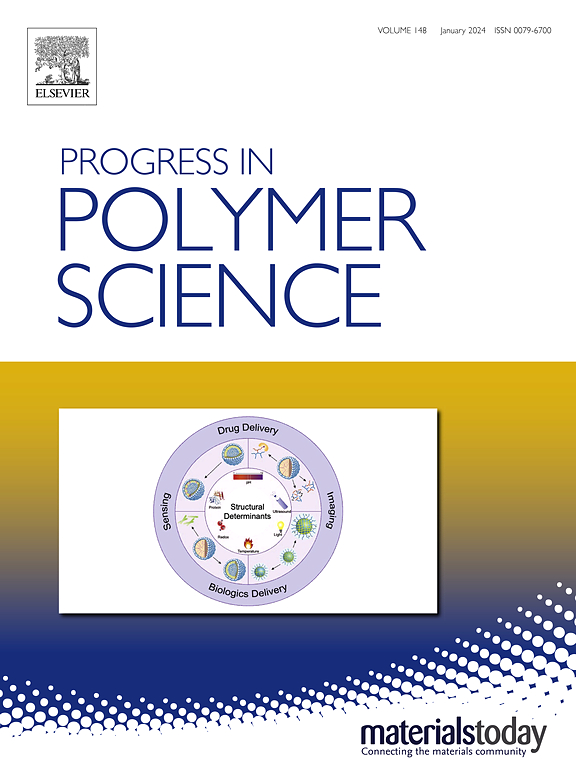Hierarchically structured materials derived from synthetic polymers: design and bulk self-assembly strategies
IF 26.1
1区 化学
Q1 POLYMER SCIENCE
引用次数: 0
Abstract
Hierarchical structures are ubiquitous in biological systems—proteins, for instance, achieve complex and precise assemblies through the hierarchical organization of amino acid sequences, enabling diverse and sophisticated functions. Inspired by nature, hierarchically structured synthetic polymers have emerged as a new class of materials capable of forming ordered morphologies with multiple periodicities, surpassing the conventional phase behavior of linear diblock copolymers. This review critically summarizes recent progress in the design and formation of hierarchical structures in synthetic polymers. We categorize current strategies into five major approaches: (1) multiblock copolymers, (2) supramolecular assemblies, (3) liquid crystalline copolymers, (4) polypeptide-based copolymers, and (5) graft/bottlebrush block copolymers. Particular attention is given to approaches that employ diverse macromolecular architectures, including linear, star, and bottlebrush polymers, to access complex morphologies. In addition, we highlight recent advances in polymer-grafted nanocrystals, which give rise to hierarchical superlattices by integrating atomic-level ordering from the nanocrystals with nanoscale periodicity from the polymer corona. We conclude by discussing emerging synthetic directions and potential applications of these hierarchically structured polymeric materials.


合成聚合物衍生的分层结构材料:设计和批量自组装策略
等级结构在生物系统中无处不在——例如,蛋白质通过氨基酸序列的等级组织实现复杂而精确的组装,从而实现多样化和复杂的功能。受大自然的启发,分层结构的合成聚合物已经成为一类新的材料,能够形成具有多个周期性的有序形态,超越了线性二嵌段共聚物的传统相行为。本文综述了合成聚合物中分层结构的设计和形成的最新进展。我们将目前的策略分为五种主要方法:(1)多嵌段共聚物,(2)超分子组装,(3)液晶共聚物,(4)多肽基共聚物,(5)接枝/瓶刷嵌段共聚物。特别关注的方法是采用不同的大分子结构,包括线性,星形和瓶刷聚合物,以获得复杂的形态。此外,我们强调了聚合物接枝纳米晶体的最新进展,通过将纳米晶体的原子级有序与聚合物电晕的纳米级周期性相结合,产生了分层超晶格。最后讨论了这些分层结构高分子材料的合成方向和潜在应用。
本文章由计算机程序翻译,如有差异,请以英文原文为准。
求助全文
约1分钟内获得全文
求助全文
来源期刊

Progress in Polymer Science
化学-高分子科学
CiteScore
48.70
自引率
1.10%
发文量
54
审稿时长
38 days
期刊介绍:
Progress in Polymer Science is a journal that publishes state-of-the-art overview articles in the field of polymer science and engineering. These articles are written by internationally recognized authorities in the discipline, making it a valuable resource for staying up-to-date with the latest developments in this rapidly growing field.
The journal serves as a link between original articles, innovations published in patents, and the most current knowledge of technology. It covers a wide range of topics within the traditional fields of polymer science, including chemistry, physics, and engineering involving polymers. Additionally, it explores interdisciplinary developing fields such as functional and specialty polymers, biomaterials, polymers in drug delivery, polymers in electronic applications, composites, conducting polymers, liquid crystalline materials, and the interphases between polymers and ceramics. The journal also highlights new fabrication techniques that are making significant contributions to the field.
The subject areas covered by Progress in Polymer Science include biomaterials, materials chemistry, organic chemistry, polymers and plastics, surfaces, coatings and films, and nanotechnology. The journal is indexed and abstracted in various databases, including Materials Science Citation Index, Chemical Abstracts, Engineering Index, Current Contents, FIZ Karlsruhe, Scopus, and INSPEC.
 求助内容:
求助内容: 应助结果提醒方式:
应助结果提醒方式:


